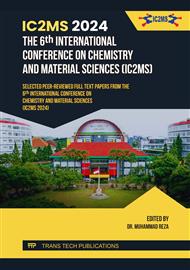[1]
K. H. H. Aziz, F. S. Mustafa, K. M. Omer, S. Hama, R. Fayaq Hamarawf, and K. Othman Rahman, "Heavy metal pollution in the aquatic environment: efficient and low-cost removal approaches to eliminate their toxicity: a review," RSC Adv., vol. 13, no. 26, p.17595–17610, 2023.
DOI: 10.1039/D3RA00723E
Google Scholar
[2]
M. El Badry Mohamed, E. Y. Frag, and M. H. El Brawy, Rapid potentiometric sensor for determination of Cu(II) ions in food samples, Microchem. J., vol. 164, p.106065, (2021).
DOI: 10.1016/j.microc.2021.106065
Google Scholar
[3]
USEPA, Maximum contaminant level goals and national primary drinking water regulations for lead and copper; final rule, 40 CFR Parts 141 and 142. Fed Reg 56:110. 1991.
Google Scholar
[4]
Pemerintah Indonesia, PP No. 22 Tahun 2021. Available: https://peraturan.bpk.go.id/Details/161852/pp-no-22-tahun-(2021)
Google Scholar
[5]
A. A. Taylor et al., Critical Review of Exposure and Effects: Implications for Setting Regulatory Health Criteria for Ingested Copper, Environ. Manage., vol. 65, no. 1, p.131–159, (2020).
DOI: 10.1007/s00267-019-01234-y
Google Scholar
[6]
G. Khayatian, M. Moradi, and S. Hassanpoor, MnO2/3MgO Nanocomposite for Preconcentration and Determination of Trace Copper and Lead in Food and Water by Flame Atomic Absorption Spectrometry, J. Anal. Chem., vol. 73, no. 5, p.470–478, (2018).
DOI: 10.1134/S1061934818050088
Google Scholar
[7]
C. Morrison, H. Sun, Y. Yao, R. A. Loomis, and W. E. Buhro, Methods for the ICP-OES Analysis of Semiconductor Materials, Chem. Mater., vol. 32, no. 5, p.1760–1768, (2020).
DOI: 10.1021/acs.chemmater.0c00255
Google Scholar
[8]
J. R. K. Silveira, L. C. Brudi, S. R. Waechter, P. A. Mello, A. B. Costa, and F. A. Duarte, Copper determination in beer by flame atomic absorption spectrometry after extraction and preconcentration by dispersive liquid-liquid microextraction, Microchem. J., vol. 184, p.108181, (2023).
DOI: 10.1016/j.microc.2022.108181
Google Scholar
[9]
D. J. Butcher, Recent advances in graphite furnace atomic absorption spectrometry: a review of fundamentals and applications, Appl. Spectrosc. Rev., vol. 59, no. 2, p.247–275, (2024).
DOI: 10.1080/05704928.2023.2192268
Google Scholar
[10]
B. P. Harp, P. F. Scholl, P. J. Gray, and P. Delmonte, Quantitation of copper chlorophylls in green table olives by ultra-high-performance liquid chromatography with inductively coupled plasma isotope dilution mass spectrometry, J. Chromatogr. A, vol. 1620, p.461008, (2020).
DOI: 10.1016/j.chroma.2020.461008
Google Scholar
[11]
F. Zhou, C. Li, H. Zhu, and Y. Li, A novel method for simultaneous determination of zinc, nickel, cobalt, and copper-based on UV–vis spectrometry, Optik, vol. 182, p.58–64, Apr. (2019).
DOI: 10.1016/j.ijleo.2018.12.159
Google Scholar
[12]
V. de O. Trinta et al., Total metal content and chemical speciation analysis of iron, copper, zinc, and iodine in human breast milk using high-performance liquid chromatography separation and inductively coupled plasma mass spectrometry detection, Food Chem., vol. 326, p.126978, (2020).
DOI: 10.1016/j.foodchem.2020.126978
Google Scholar
[13]
N. Aslan, Z. Koçak, H. E. Kormalı Ertürün, and N. Şen, Analysis of Copper(II) Ions in Human Blood Using a New Solid-Contact PVC Membrane Potentiometric Sensor Based on a N,N'-Bis(salicylidene)-1,3-diaminopropane Schiff Base, Anal. Bioanal. Chem. Res., vol. 10, no. 2, p.193–204, (2023).
Google Scholar
[14]
E. Zdrachek and E. Bakker, Potentiometric Sensing, Anal. Chem., vol. 91, no. 1, p.2–26, (2019).
DOI: 10.1021/acs.analchem.8b04681
Google Scholar
[15]
O. Özbek, Ö. Isildak, and C. Berkel, The use of porphyrins in potentiometric sensors as ionophores, J. Incl. Phenom. Macrocycl. Chem., vol. 98, no. 1, p.1–9, (2020).
DOI: 10.1007/s10847-020-01004-y
Google Scholar
[16]
S. Kaur, V. Kumar, M. Chawla, L. Cavallo, A. Poater, and N. Upadhyay, Pesticides Curbing Soil Fertility: Effect of Complexation of Free Metal Ions, Front. Chem., vol. 5, p.43, (2017).
DOI: 10.3389/fchem.2017.00043
Google Scholar
[17]
V. K. Gupta, B. Sethi, N. Upadhyay, S. Kumar, R. Singh, and L. P. Singh, Iron (III) Selective Electrode Based on S-Methyl N-(Methylcarbamoyloxy) Thioacetimidate as a Sensing Material, Int. J. Electrochem. Sci., vol. 6, no.3, p.650–663,(2011).
DOI: 10.1016/S1452-3981(23)15023-1
Google Scholar
[18]
J. Zhai, D. Yuan, and X. Xie, Ionophore-based ion-selective electrodes: signal transduction and amplification from potentiometry, Sens. Diagn., vol. 1, no. 2, p.213–221, (2022).
DOI: 10.1039/D1SD00055A
Google Scholar
[19]
T. Awad Ali, A. A. Abd-Elaal, and G. G. Mohamed, Screen printed ion-selective electrodes based on self-assembled thiol surfactant-gold-nanoparticles for determination of Cu(II) in different water samples, Microchem. J., vol. 160, p.105693, (2021).
DOI: 10.1016/j.microc.2020.105693
Google Scholar
[20]
Q. Zhang, C. Wang, L. Yu, J. You, G. Wei, and J. Zhang, Structural and Transport Properties of Hydrophilic and Hydrophobic Modified Ionomers in Proton Exchange Membrane Fuel Cells, 2024.
DOI: 10.3390/polym16050668
Google Scholar
[21]
M. Jozanović, N. Sakač, M. Karnaš, and M. Medvidović-Kosanović, Potentiometric Sensors for the Determination of Anionic Surfactants – A Review, Crit. Rev. Anal. Chem., vol. 51, no. 2, p.115–137, (2021).
DOI: 10.1080/10408347.2019.1684236
Google Scholar
[22]
I. Kaur, M. Sharma, S. Kaur, and A. Kaur, Ultra-sensitive electrochemical sensors based on self-assembled chelating dithiol on the gold electrode for trace level detection of copper(II) ions, Sens. Actuators B Chem., vol. 312, (2020).
DOI: 10.1016/j.snb.2020.127935
Google Scholar
[23]
C. J. Murphy et al., Impact of branching on the supramolecular assembly of thioethers on Au(111), J. Chem. Phys., vol. 142, no. 10, p.101915, (2015).
DOI: 10.1063/1.4907270
Google Scholar


